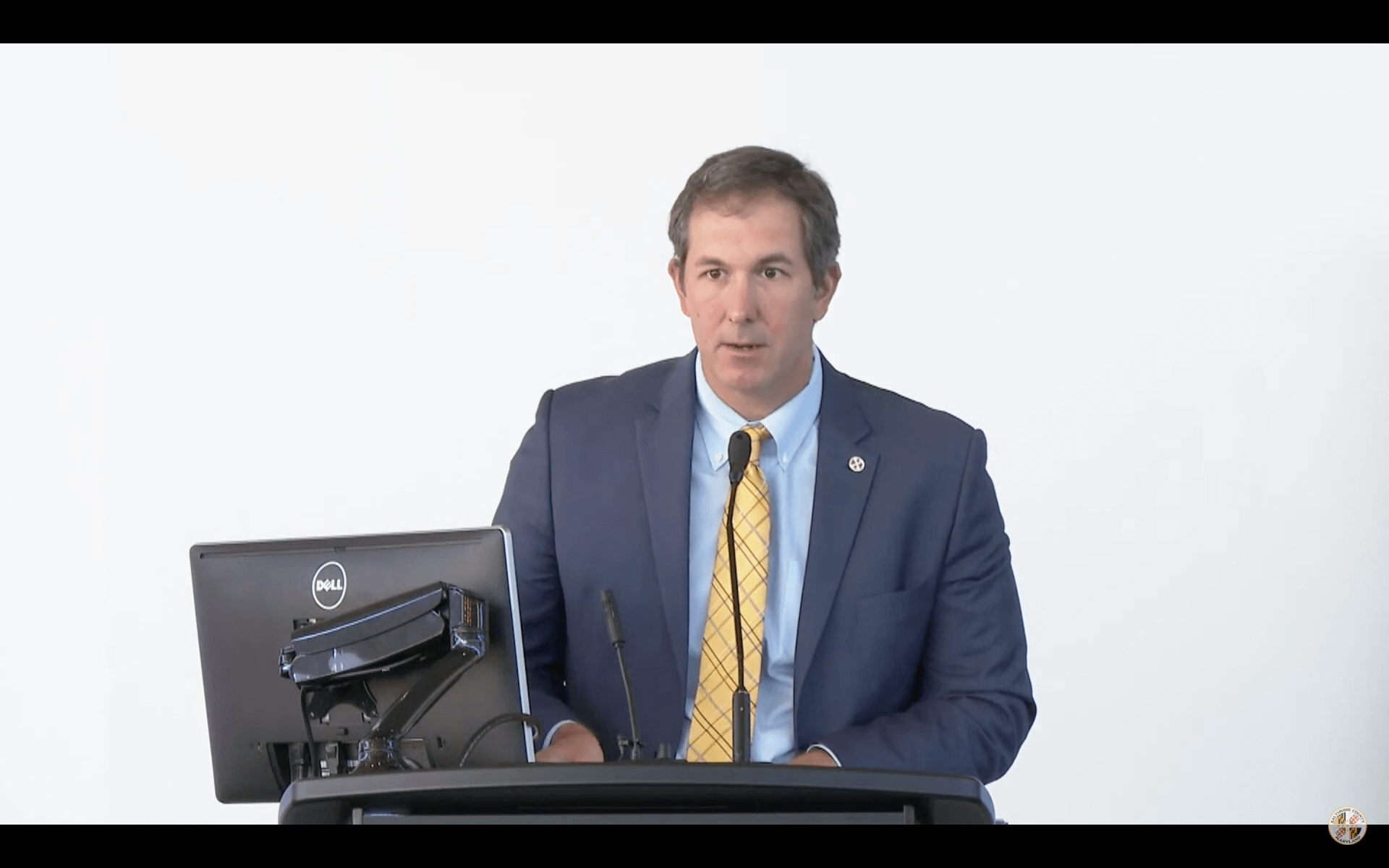Olszewski Accuses MDOT of Neglecting Baltimore County’s Needs

Baltimore County Executive John A. Olszewski Jr. (D) accused the state’s top transportation officials on Wednesday of short-changing his jurisdiction by funneling more money to the Washington, D.C., suburbs than to his county.
In remarks at Towson University, he called for “more sustained support and partnership” from state budgeteers.
“Our county has historically been underfunded, while other large jurisdictions receive much more,” Olszewski said. “We know that our residents deserve the investments and partnership necessary to make this 21st century transportation vision a reality.”
Olszewski — who considered a run for governor in 2022 but chose to seek reelection instead — displayed a slide that compared “locally operated transit system funding” for Maryland’s largest counties. It showed that Montgomery and Prince George’s receive $30 million and $10 million each year, respectively, while Baltimore County receives $421,000.
He reeled off a list of transportation projects and neighborhood improvements that the county has paid for or that have been deferred due to lack of state funding, including a request to upgrade the interchange at Interstate 795 and Dolfield Boulevard in Owings Mills that dates back to 2007.
The executive’s remarks came during the Maryland Department of Transportation’s “annual consultation meeting,” a fall tour that takes the agency’s secretary and other top officials to all 23 counties and Baltimore City.
The meetings give local leaders a chance to provide feedback on the agency’s plans — and to spotlight specific requests made by constituents.
MDOT just unveiled a $16.4 billion draft Consolidated Transportation Program (CTP), a rolling six-year spending blueprint for fiscal years 2022-2027. The plan will be submitted to the General Assembly in January.
Olszewski’s comments echoed those made last week in the Baltimore, when Mayor Brandon M. Scott (D) and other city leaders complained that the state appears to favor the D.C. suburbs when it doles out transportation funds.
“We cannot sit back and watch dollars continue to flow to other parts of the state while our infrastructure suffers,” said city transportation director Steve Sharkey, according to The Baltimore Sun.
“We are going to be vocal and we are going to continue to push for the investment that the City and the region needs to compete and prosper economically.”
Advocates for the Baltimore region and transit boosters remain angry with Gov. Lawrence J. Hogan Jr.’s 2015 decision to kill the long-planned Red Line in Baltimore that had qualified for billions in federal aid.
At the time, the Republican governor called the transit project a “wasteful boondoggle.”
As he pulled the plug on the Red Line, an east-west link that supporters said would have offered educational and job opportunities to people who lack access to cars or reliable transit, Hogan gave his approval to the Purple Line, which will connect inner-Beltway communities in Prince George’s and Montgomery counties.
Hogan was also instrumental in building crucial financial support for the Washington Metropolitan Area Transit Authority, which provides bus and rail service in the D.C. region. And he has championed a multi-billion dollar plan to speed travel along two of the nation’s most congested highways, the Capital Beltway and Interstate 270 in Montgomery County.
“Unfortunately, the Baltimore region has suffered for years from a lack of adequate state funding for transportation system maintenance and investment in new projects,” said Donald C. Fry, president of the Greater Baltimore Committee, in a statement.
“This lack of investment in the Baltimore region runs the risk of depriving work commuters, especially those unable to afford cars or other transportation options, with access to jobs or employment opportunities,” he added. “It is a priority equity and diversity issue that must be addressed fully and fairly.”
Transportation Secretary Greg Slater, who was seated a short distance from Olszewski on Wednesday, did not directly respond to the executive’s comments.
But he said his agency is making “historic” investments in “system preservation,” much of it maintenance work on buses and rail service in and around Baltimore. And there is new money proposed for the Maryland Aviation Administration, to support the expansion of Southwest Airlines at Thurgood Marshall BWI Airport.
Slater also noted that the state is pouring money into the Port of Baltimore, including the recent purchase of four new cranes that just arrived from China.
In addition, he said that the state has embarked on two transit studies — an east-west line that would run from Bayview through the city into Ellicott City, and a north-south line that would link Towson and downtown Baltimore.
The draft fiscal year 2022-27 CTP is $1.2 billion bigger than last year’s, and it is one of the largest ever proposed.
But questions remain about whether the Baltimore region is getting its fair share.
Brian O’Malley, head of the Central Maryland Transportation Alliance, said MDOT has been “vague” about how it is using billions in new federal aid.
He expressed concern about the growing cost of the Purple Line, which has been beset by upheaval, saying, “I find it all confusing. What’s the total bill?”
And O’Malley noted that Maryland’s funding lifeline to WMATA appears to extend indefinitely, while Hogan vetoed a measure to ease a maintenance backlog at the Maryland Transit Administration in May.
“We can see WMATA’s share of the capital budget has gotten bigger, and so why are we treating different parts of the state differently?” O’Malley asked.
He urged the General Assembly to override Hogan’s veto in December, when lawmakers are expected to return to Annapolis for a special session.




 Creative Commons Attribution
Creative Commons Attribution